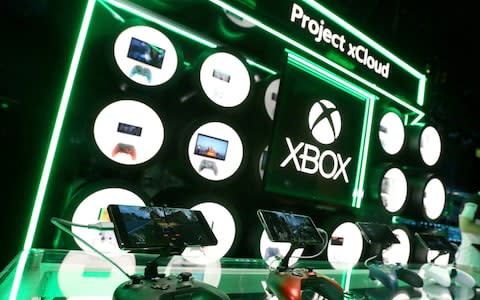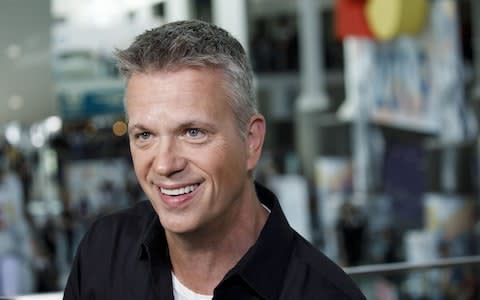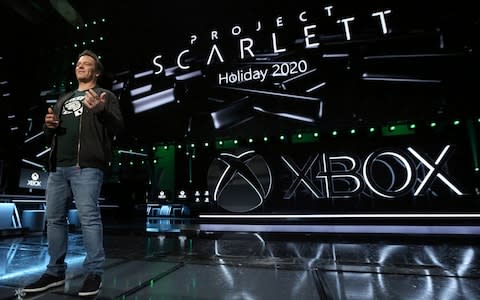Xbox E3 2019 interview: Project Scarlett, Xcloud and why Game Pass is the 'centre of gravity' for Microsoft

Microsoft grabbed most of the headlines at E3 2019, the gaming industry’s biggest showcase, with the announcement of its next-generation successor to its Xbox One console.
Project Scarlett, as it is currently codenamed, appeared at the end of the Xbox press briefing with an impressive graphical showcase of Scarlett launch title Halo Infinite and developers lauding its technological prowess. Four times more powerful than the current Xbox One X, said Xbox boss Phil Spencer.
But the slightly nebulous proclamation raised almost as many questions as it answered. At this point, the existence of Project Scarlett is a tease preparing dedicated games players for its Christmas 2020 release, but keeping much of the details under wraps for now.
Here is what we know so far. Project Scarlett will come with a solid-state drive (SSD) that will all but eliminate load times, it will be capable of 8K resolution output (of some description) and 120 frames per second and modern graphical capabilities such as ray-tracing. This is enabled by a custom CPU technology by AMD and GDDR6 Ram. Questions about cost, form factor and if there will be different models have been offered a resolute “we’re not ready to talk about that yet.”
Presumably this is because many of those details are in flux, but also because Microsoft has its eyes firmly set on a broader goal than selling new hardware. That of creating the so-called ‘Netflix of gaming’ with its Xbox Game Pass subscription model. Project Scarlett and its forthcoming cloud gaming service Project Xcloud - which will allow you to stream Xbox games to your phone - grabbed the headlines, but they are the vessels for Microsoft’s grander plans for its gaming future.

Is Xbox Game Pass the 'Netflix of games'?
“Game Pass is our centre of gravity,” head of Xbox Game Studios Matt Booty tells me backstage at the Microsoft Theater in downtown LA. “So no matter how you’re going to play your games, whether it’s a device in your living room or if it’s streamed to a phone, Game Pass is going to be the centre of that, that’s where your library of games lives.
“And we really have focussed everything around the player, we think about what informs how you’re going to go about streaming, what informs Project Scarlett, what informs the studios you are acquiring. You’re talking about a lot of stuff that’s been going on over the last year.”
The Game Pass service as it stands has subscribers paying a flat monthly rate to access a library of games that they can download to their Xbox One console and PC. The majority of Microsoft’s first-party games now appear on the service at the same time they are released to buy standalone. This has been a significant strategy shift away from the traditional way of buying games and one that Microsoft has found success in. Booty says that games that have been played on Game Pass have actually seen a lift in retail sales as more people are trying them out.
It brings another Netflix comparison, in which the TV streaming giant has spent billions on original content, whereas Microsoft has recently spent big on several new studios. But Booty thinks that the idea of a ‘Netflix for games’ is too simplistic.
“I think the Netflix thing is easy for us to talk about because it’s something everyone has,” he says. “I think we could use Spotify as an example aswell. But I think we’ve got to be careful as to not overdo the comparison. Because people play games differently than they watch TV and we as the platform owner have insight in how long people play a certain game, how long they play before they move onto a certain other game.
“There is a different way that we consume things. I think the term means that people are more comfortable with a subscription model. They’re more comfortable with digital content.”

Will subscription services be gaming's new battleground?
Microsoft has taken a lead with Game Pass when it comes to the newly minted area of gaming subscriptions. But may find itself under pressure from more rivals soon as the industry shifts towards the model. Google Stadia will have a Premium subscription model tied to its cloud platform, French publisher Ubisoft has announced its own Uplay service, while Apple will also launch its ‘Arcade’ subscription model later this year. In the past, the battle for supremacy in the gaming market has been fought over hardware: the console wars. But with so many companies turning to subscription as a primary concern, are we on the brink of a new subs war.
“Maybe,” says Booty. “I think the way we look at that is who has advantages and who has capabilities. We think about content, community and cloud. We think we’ve got a great advantage in content with a library of thousands of games, we have franchises that have taken decades to build; Minecraft, Halo, Gears, Forza. We have a line-up of new studios designed to bring new IPs into the line-up.
“And cloud, Microsoft has the infrastructure and experience running data centers around the world and connecting them at scale. You start to think about them and connecting them at scale. You start to think about, ok, Amazon has cloud, Google sort of has cloud. Then we have our community where we have 60 million plus people on Xbox Live.
“It would be a good exercise to think about who’s got what and what are the strengths of each of those. I personally feel good about ours because I think it’s going to take all three of those to succeed.”
Competition and co-operation for Xbox, PlayStation and Nintendo
Selling more consoles than the other guys, while still vital to the gaming infrastructure, is perhaps not the be all and end all for platform holders like Microsoft and Sony. Indeed, there has been a recent trend of co-operation between the traditional gaming ‘big three’ of Xbox, PlayStation and Nintendo. Is this a concerted effort for those companies to protect their turf from the potential threat of Google and, if rumours are to be believed, Amazon.
“It’s less so much about that,” says Booty. I frame it around players. If we know there are a bunch of Minecraft players on PlayStation and a bunch on Xbox we want to connect them so they can play together. We’ve done it with Minecraft on Xbox and Switch. I think you’ll see us do more on other platforms.
“Both Sony and Nintendo have been amazing partners with us on something like Minecraft. Sony’s a big company, Microsoft is a big company and I think there will be places where we co-operate and there will be places we compete. I think that those things happen because of individual relationships, not necessarily because we all happen to sell a device and let’s all have all the console people get together and we’re going to go take out the non-console guys. That’s not really how we think about it.”
Xbox Project Scarlett: Where does Microsoft's new console fit in?
The common thread of consoles remain, however, and Booty says that Project Scarlett “fills a couple of pieces of the puzzle”.
“There are always going to be people that want to play in their living room and they’re going to have the biggest, best screen,” he says. “The console is going to make sense. We still want that group of people and we want to make sure they’ve got something that’s very modern and up to date and is going to provide the most immersive console experience we can come up with.”

Booty says that while Scarlett will offer the best ‘premium’ experience for playing the latest blockbuster games, it will also help to drive the technology behind Xcloud. The same team that is developing the new console is also working on the ‘blades’ that make up the Xcloud servers.
“We look at streaming and expanding our strategy and expand our market, that same design, the same silicon and chip layout, that is what’s going to power our cloud solution racked up in a datacenter,” Booty says. “It’s not just about delivering the device in the living room, it’s about providing a technology foundation for what’s going to drive Project xCloud.”
As it stands, Xcloud is powered by Xbox One technology ahead of its launch later this year. But Booty says you can “start to connect the dots and see where that’s going to go” when it comes to streaming Scarlett games in the future.
The end of the exclusive?
Many of these games, however, will not be ‘exclusive’ in the sense that Microsoft are committed to publishing most of its games on PC. Booty says that it is up to individual teams if they want to develop games exclusively for Scarlett, but that it isn’t a priority for Microsoft in the same way it used to be
“I think the idea of a game that just runs on one device for the sake of running on that one device is going to become less and less common,” he says. “That said we don’t dictate to our teams what they do. It’s up to the teams to decide where the content they’re making belongs. In the case of something like Minecraft, they may decide it belongs on 20 platforms, but in the case of Forza they might say ‘no we write every bit of code to run great on Xbox and that’s where it’s going to belong’.
“If a team decided they were going to build a game that absolutely cannot have load times and we’re going to take advantage of the SSD on Scarlett: great. But at the same time if a team came in and said our game is more about audience and multiplayer and we’re going broad as we can then great, go and do that.”
The questions and curiosity over Project Scarlett will continue as its release date draws ever closer. There will always be an intrinsic link to new technology in games, even with the advent of cloud gaming. But from now on it seems likely that new consoles like Scarlett --and potentially the PlayStation 5-- will drive new games for subscription services that also spread across multiple devices. If handled in the right way, this could be conducive to players trying new things.
“When I think about Game Pass, it’s about curation and discovery,” says Booty. “The last thing we want is for any subscription service to turn into a flea market. You want to know that if you’re going to get something from Game Pass it’s going to be good quality, it might be a game that’s quirky, or a big game. I’m going to feel a lot more comfortable browsing a bunch of different games and trying different kinds of games if I’ve already paid for them.
“With music I’ll try out all kinds of channels on Spotify. I’m old enough to remember that buying music was like… ok I liked that one song but I don’t know if I want to buy this whole CD to get that one song. It’s almost comical to think about now that you would do that, but I think Game Pass kind of solves that. We hope it helps games to go on and grow.”
No doubt, with Game Pass and all the relevant technology, Microsoft will be hoping Xbox continues to grow too.

 Yahoo Finance
Yahoo Finance 